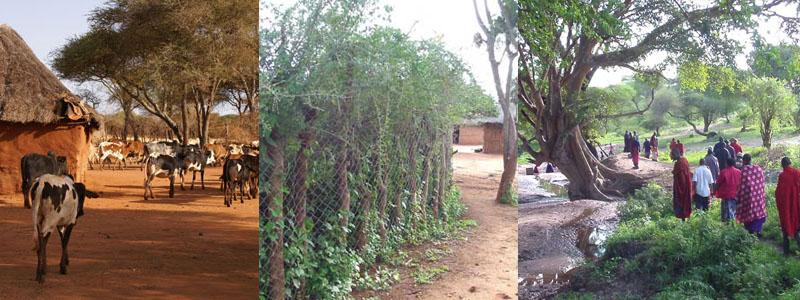Drawing upon Community in Tanzania

Between 2011 and 2014, I made 3 visits to African People & Wildlife (APW), a community conservation organization based on the Maasai Steppe, northern Tanzania. APW envisions a world where Africa’s people and wildlife coexist and thrive in vibrant, healthy landscapes and they achieve this through innovative efforts on the ground and unrivaled community engagement expertise. During my visits I sketched, taught art classes for local school children, helped children design and paint murals, created a Village Exhibit, and learned about the wide variety of APW community and conservation programs. I was hoping to sketch in and around villages and Maasai homesteads, drawing some of the large cattle herds and Maasai men and women in their colorful shukas (robes), however I am careful to ask permission and not offend anyone in any way. The great thing about having a sketchbook is that people can come up and look over your shoulder and I found that most people were interested in what I was doing. I send laminated copies of sketches back to the people who appear in them, and it was wonderful to see the reaction of many in the communities who welcomed me back on my subsequent visits. At the conclusion of my visits, my field sketches and studio paintings became part of my traveling exhibition, Lions, Livestock & Living Walls: an Artistic Study of Community & Conservation in Tanzania, which visited New York, Connecticut, New Jersey and Vermont, with a percentage of the sale proceeds donated to APW. I continue to work with APW and was delighted to be asked to join their International Advisory Council.

Sketching among the Maasai in Tanzania
Human-wildlife conflict is widespread in Tanzania because people and livestock live in close proximity to wildlife, and reserves are unfenced. As a result conflict occurs when elephants and other herbivores eat people’s crops; when livestock and wildlife are competing for access to scarce water resources, and when predators kill people’s livestock. APW helps to mitigate this last source of conflict through the construction of Living Walls, bomas (corrals) used to hold livestock at night. Traditional bomas are created by cutting and piling up thorny acacia branches, which need replacing every few months, leading to localized deforestation. Living Walls are built from living fence posts from the Commiphora tree species (cutting even thick branches does not kill the tree), combined with wire chain link fencing. APW contracts with individual families to install a Living Wall, focusing first on homesteads where levels of conflict with predators is high. The family pay 25% of the cost of the wire, and cut the Commiphora posts, then APW provides instruction on the installation, although the family provide the labor. Living Walls have been 99.9% effective in preventing predators killing livestock at night, and new Living Walls are being installed every year (in 2024 there were more than 2000 in place). The walls reduce habitat destruction because they do not require repeated cutting of thorn bushes, and they reduce the burden on women, because they require no maintenance once planted. Significantly, the reduction in depredation events (the killing of livestock by predators) due to the construction of Living Walls, did not increase the number of predator attacks on non-fortified bomas or on livestock at pasture, and a recent study shows people who own Living Walls are more likely to be positive and optimistic about coexisting with large carnivores.

Maasai homestead; Living Wall; Loibor Siret stream
This innovative and highly successful program interested me immensely and as I sketched existing Living Walls at Maasai homesteads I began to think about portraying this in a painting. Working on a piece like this is like completing a jigsaw puzzle, where you have a collection of pieces and you have to find a way to fit them together to form a coherent painting. The difference is that I can change the puzzle pieces as I go along and there is no picture to show me what I’m trying to create!
My June 2014 visit was a whirlwind of activity. I helped design and paint classrooms and a mural for the end wall of the Loibor Siret school, I was invited to be guest of honor at the official end of school session, and I organized a Village Exhibit. The exhibit consisted of laminated copies of all the sketches I created during my visits to the area, plus large poster copies of studio paintings, including several of my conservation-themed artworks. These were hung around the school, along with artwork by the children I taught during my visits. The sketches were given away as prizes to children from the Noloholo Simba Club (school wildlife club set up by APW) during a quiz in which the children were asked questions about their environment or about Tanzania. The posters were given to APW to use in the decoration of the Noloholo Environmental Center (APW’s headquarters) and the Loibor Siret library. The idea behind the village exhibit was to allow children to see an art exhibition showing the beauty of their homes, the people who live there and the wildlife which shares the land.
APW recognizes that the future of African peoples and the future of African wildlife are inextricably linked because it is virtually impossible to conserve wildlife while people nearby live in poverty. The most effective conservation programs are usually those which are made by local communities and which also benefit local communities. Through education and empowerment programs, APW believes that local communities can achieve increased income and opportunities by conserving their own unique natural heritage.
Conservation-themed paintings based on my visit to APW. Click on the images to read more about these paintings.